

“At first, I thought I was fighting to save rubber trees,
then I thought I was fighting to save the Amazon rainforest.
Now I realize I am fighting for humanity.”
Chico Mendes, Brazilian Environmentalist
“Mother Earth” by Wuauquikuna (courtesy of Wuauquikuna Official):

“Destroying rainforest for economic gain is like
burning a Renaissance painting to cook a meal.”
E. O. Wilson – American researcher, theorist, naturalist, and author
“Dreams of the Winds” (courtesy of bardmyUTube):


The Amazon River in South America is the largest river by discharge volume of water in the world. There is some dispute about whether the Amazon is actually longer than the Nile. Its length is at least 4000 miles from its source Mantaro River to its mouth in the Atlantic Ocean on the northeastern coast of Brazil; a length that is similar to the distance from New York City to Rome. The Amazon River runs through Guyana, Ecuador, Venezuela, Bolivia, Brazil, Colombia, and Peru.
Exploring in Peru (courtesy of Drink Tea & Travel):

A quick guide to the Amazon (courtesy of FactSpark):
The Amazon River was named after the fierce women of Greek mythology known as Amazons. On Sunday 12th February 1542, a small party of Spaniards, led by Francisco de Orellana, a one-eyed conquistador, chanced upon the river while looking for cinnamon.
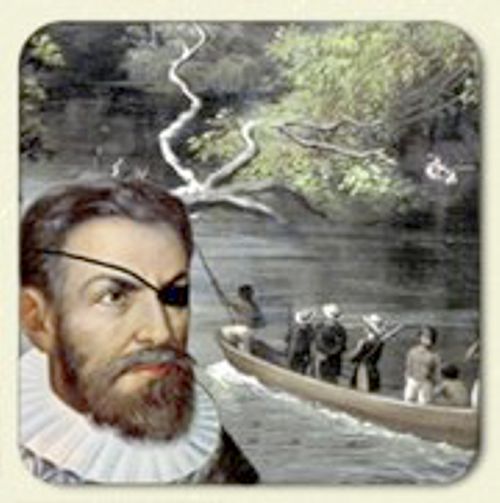

Above is the bust of Francisco de Orellana in his birthplace of Trujillo, Extramadura, in Spain.
De Orellana gave the river its name after reporting pitched battles with tribes of female warriors, whom he likened to the Amazons of Greek mythology. His awe and amazement at the river in flood are registered in his writing: “It came on with such fury and with so great an onrush that it was enough to fill one with the dreadest fear to look at it, let alone to go through it… and it was so wide from bank to bank from here on that it seemed as though we were navigating launched out upon a vast sea.” Orellana’s discovery brought Europeans to descend on the river of the Amazons. It wasn’t a happy time for the natives.
Lost Cities of the Amazon (courtesy of National Geographic):
The image below shows the battle between the Greeks and the Amazons depicted on a marble sarcophagus on display in the Octagonal Court of the Pio Clementino Museum in Vatican City.
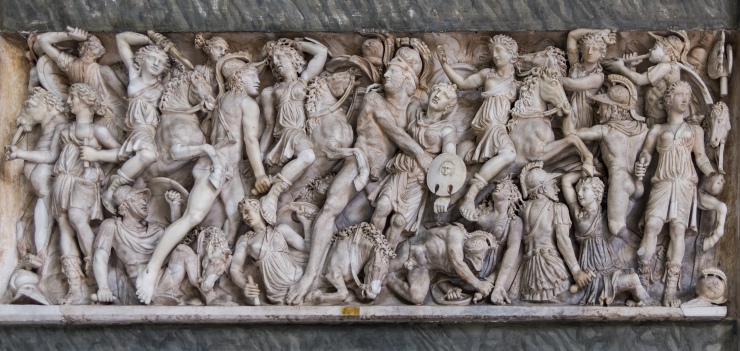
Later on, Europeans noticed a tree that the natives called ‘the wood that weeps’. A French polymath, who travelled down the river in 1736, sent a specimen to Paris. But for a century the West had no serious need of rubber. The Industrial Revolution, and Charles Goodyear’s vulcanisation process which ensured rubber’s constant consistency, changed all that. The Amazon became a second Klondike and rubber its black gold. Under the auspices of Kew Gardens, Henry Wickham smuggled 70,000 Brazilian rubber seeds to London. Only 2,000 germinated, but it was enough to start plantations in Malaya and Ceylon. The riches of the Amazon were no more.
Below is shown latex sap oozing from the rubber tree.
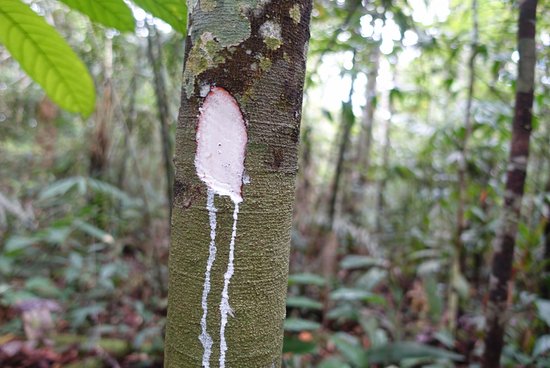

The story of Chico Mendes (courtesy of Vox):
The Amazon river runs through the rainforest rather than alongside roads and for that reason it didn’t have bridges until one was built in 2011 in Manaus, the largest city on the border of the Amazon in Brazil.
Below is shown the Rio Negro bridge in Manaus.

Flight over the Amazon and Manaus (courtesy of Georg Fietz):
In 2007 a Slovenian man named Martin Strel swam a record-breaking length of the Amazon River (3,273 miles), covering ten hours a day for 66 days. It was a great achievement, but all I can say, rather him than me. If I was tempted to attempt such a journey, I think my family would wait at the end of the my swim with the men in the white coats. You will understand why when you read about the animals that live in this river. To ensure that you are fully dissuaded from attempting his endeavour, you should note that the escort boats which were following Martin were prepared to pour blood into the river to distract meat-eating fish such as piranhas!

Above is Martin Strel undertaking his epic swim along the Amazon River.
Courtesy of UPROXX Studio:
The Amazon River is one of the natural wonders of the world, flowing through the remote Amazon rainforest. The river is made up of over 1,100 tributaries, seventeen of which are longer than 1,600 km. Marajo, the world’s largest river island with an area of 48,000 square km is located on the Amazon and is about the size of Switzerland.
Image below shows the mouth of the Pará River in Brazil, part of the greater Amazon River system. The river is separated from the larger part of the Amazon delta by Ilha de Marajó (Marajo Island).

“River Journey” by Wayra:
The Amazon River is 11 million years old. It originated as a transcontinental river, and it took its present shape approximately 2.4 million years ago. Its great importance is the fact that the rivers connected with the Amazon flow directly into the ocean maintaining the ocean currents, and therefore controlling the region’s climate.

Animal life of the Amazon River is difficult to assess fully because of the great diversity of its flora, some still not identified. The river is vibrating with about 2,500 fish species, and the forest canopy above resonates with the cries of many birds, monkeys and chirruping insects. There is a notable paucity of the largest terrestrial mammal species, indeed many mammals are arboreal. Among the many animals are caimans, river turtles, and the largest semiaquatic capybara, the largest in the world rodent.
Below is Black Caiman (image courtesy of International Expeditions).

Below is South American River Turtle (image courtesy of International Expeditions).
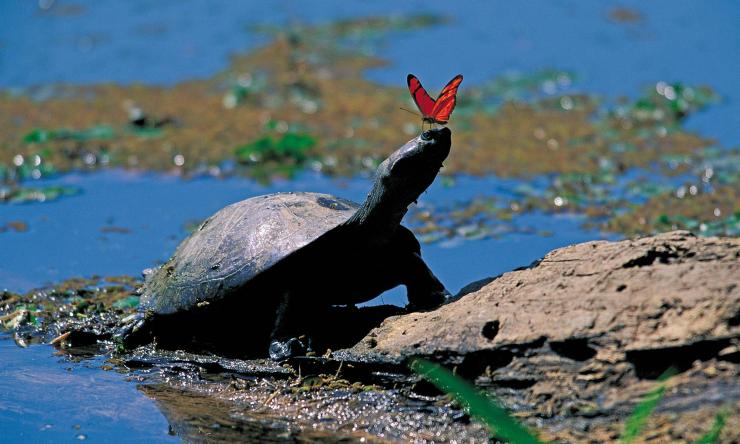
Below is a family of Capybaras (image courtesy of International Expeditions).

In the river, the most important ones are the Pirarucu, one of the world’s largest freshwater fish, and various giant catfish. The small flesh-eating piranha generally feeds on other fish but may attack any animal or human that foolishly enters the water.
Below is shown the benign countenance of the red-bellied Piranha.

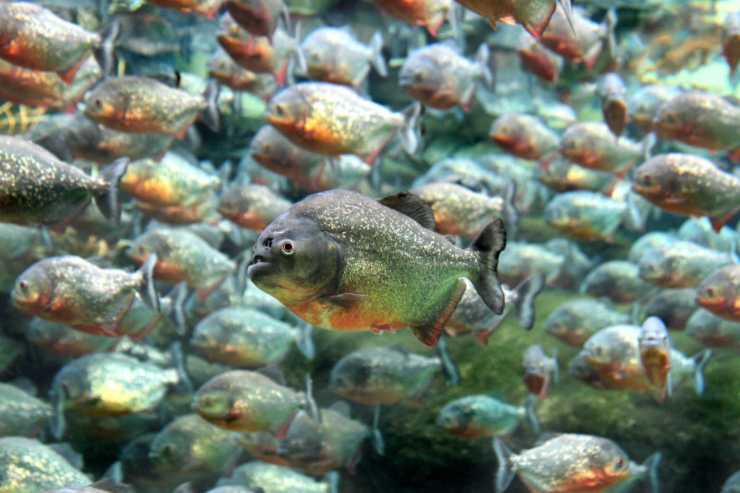
The Amazon River is the prime habitat of Boto, the largest species of river dolphins and which is also known as the Amazon River Dolphin. Another dolphin, the Tucuxi is also found in the Amazon basin and coastal waters. The largest freshwater fish in the world, the Pirarucu have been found to reach a length of 4 metres and can weigh close to 200 kilograms.
Below is Boto, the pink Amazon river dolphin (second image courtesy of International Expeditions).


Courtesy of BBC Earth:
Below are Tucuxi river dolphins in the Amazon

The Mighty Amazon and River Dolphins (courtesy of BBC Studios):
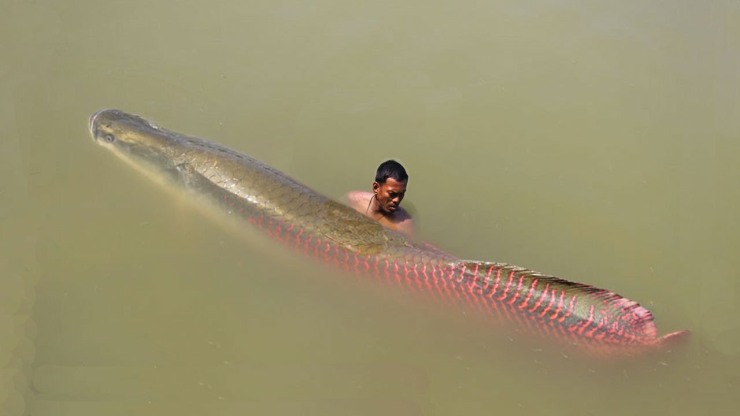

Above are shown photos of Pirarucu (arapaima gigas).
And now try to read with your hands over your eyes, the way I am writing: in the shallow waters of the Amazon Basin lurk Anacondas, the largest snakes in the world. They grow to 5 metres (17 feet), and weigh 550 pounds! They occasionally attack larger animals, like goats, that have got too close to the water, but they wouldn’t say no to a tasty human. Goodbye, Amazon! I am not, ever, coming to see you!
Below is Green Anaconda (image courtesy of International Expeditions).
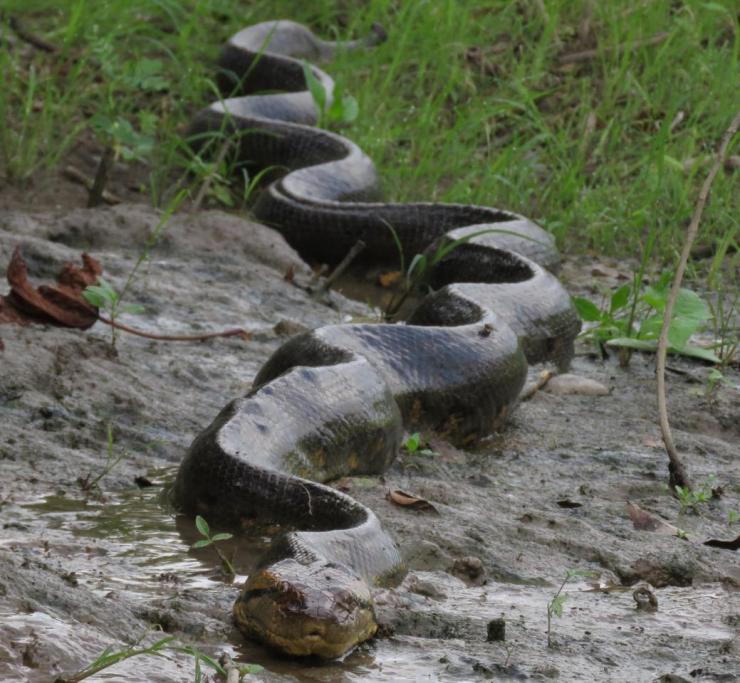
Perhaps more than you wish to know about these creatures (courtesy of Nat Geo WILD):
Some adventurers braver than me! (courtesy of BigAnimals Expeditions):
By the way, the Italian composer Ottorino Respighi faced his fear of coming face to face with snakes at Rio’s zoo in his “Brazilian Impressions.”
“Butantan” (In a snake-garden) from “Brazilian Impressions” (courtesy of Billy Stewart):
The forest fires in the Amazon rainforest happen naturally, but in the last year or so most were started by farmers and loggers clearing land for crops. Shame.

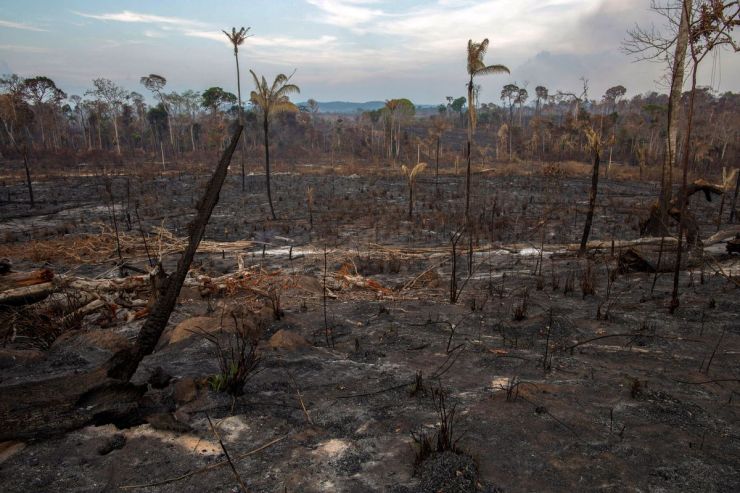
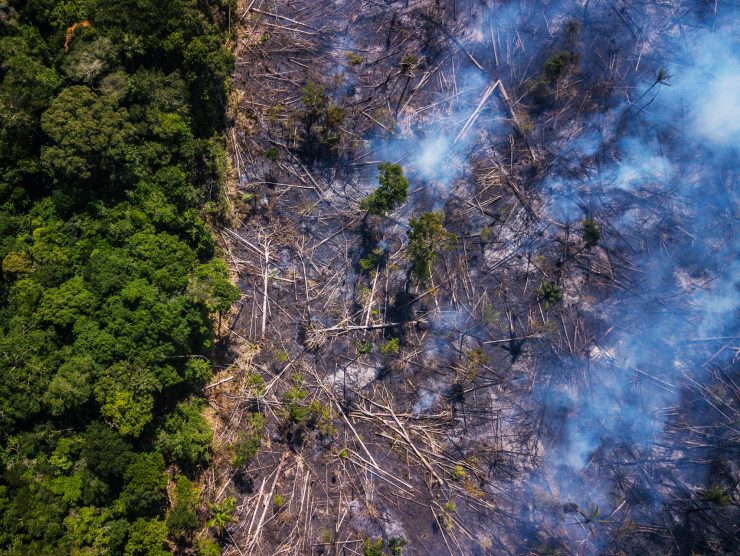

Courtesy of Behind the News:
“Under The Canopy” (courtesy of Conservation International):
The man who grew his own rainforest (courtesy of BBC World Service):
And finally, I think that you may have noticed that the most frequently used words in this post are:
THE LARGEST IN THE WORLD!

Another spell binding post. Like you do not need to know anything if you are on a flight to brazil. To an extent you can even surprise some Brazilians on board with this knowledge. And above all it feels a start of a another project to publish a children’s(at least) book of learning about the greatest rivers vibrating on earth.
I am happy to be able to not just review it but immerse myself in this series on rivers. Joanna’s insatiable curiosity in telling us readers about the true values of nature keeping and caring for each element and beings in all aspects dipped in history, glory, culture, people, animals are a delight for us readers. Her research shows her love and her presentation, precision.
Its easily the most important blog on blogosphere. And we are blessed to have known its source.
Thank you.
Narayan x
LikeLiked by 2 people
A fascinating post, Joanna! History, zoology, geography, ecology, natural beauty, music, politics, human interest stories…I have enjoyed this post very much!
I hope the destruction of the rainforest can be stopped, and the land restored for the benefit of people worldwide. I also thought of the indigenous people being displaced by development and of people living in the terrible slums in Brazil’s large cities. The welfare of all these people needs to be addressed. Surely, equitable solutions can be found in Brazil and throughout region.
This is the first post in your river series that I have read/watched. I look forward to your posts on other rivers.
Wishing you a lovely holiday season. 🙂
LikeLiked by 2 people
Thank you, Narayan, for your beyond wonderful comments! I truly believe that there is never enough written about the influence of nature on our lives. And so I will continue to show the wonder of trees, plants, flowers – the essence of the world, and the delights of meeting all the creatures that share this planet with us. After Christmas, I will come back to the Great Rivers of the World.
Joanna x
LikeLiked by 1 person
Thank you again, Narayan, for the praise, I am not sure I deserve it as it is a privilege to write about Nature!
Your comments are greatly appreciated!
Joanna x
LikeLiked by 1 person
My Dear Cheryl, thank you so much for your generous and kind comments. I agree with your concerns. If you have time after Christmas, perhaps you could catch up with the other river posts – The Ganges and The Mississippi.
Please, don’t miss my Christmas post on the 24 of December, as the more uplifting story would be difficult to find!
Joanna
LikeLiked by 2 people
Thank you again, Dear Cheryl. Greatly appreciated!
Joanna
LikeLiked by 2 people
Wow beautiful pictures ,brilliant post ❤️
LikeLiked by 2 people
Thank you, that is so sweet of you! Are you old enough to read about anaconda without being scared?
Joanna
LikeLiked by 2 people
Thank you again. Greatly appreciated.
Joanna
LikeLiked by 1 person
The girl is my niece, I’m a grown ass guy dear ☺️
LikeLiked by 1 person
You are always welcome ❤️
LikeLiked by 1 person
Thank you. I suspected as much!
LikeLiked by 1 person
You got yourself another follower, regards to your niece.
LikeLiked by 2 people
Wow, thanks dear ❤️
LikeLiked by 1 person
So interesting! And wonderful images, thank you. 💖
LikeLiked by 2 people
Thank you, Morag, for your kind comment! If you can, please, do look up my last post about the birds, as you will like it, it is called:
“The Wonders of How Animals Find Their Way”.
Joanna
LikeLiked by 1 person
Thank you, Morag, again. Greatly appreciated.
Joanna
LikeLiked by 1 person
Thank you, I definitely will do so 😊
LikeLiked by 1 person
Thank You!!
LikeLiked by 1 person
The Amazonas, one of the great wonders of our world! Although I visited Brazil several times, I have not been to the Amazonas yet, and I certainly would not dare to swim in it but I admire those that do. Thank you for this very informative post with the beautiful photos.
LikeLiked by 2 people
Thank you, Olivia, for your kind comment!. I think anaconda would put me off even coming anywhere close!
Joanna
LikeLiked by 1 person
Yes, gaby, the anaconda is certainly not a pleasant pet!
LikeLiked by 1 person
Just one thing here, Olivia; I am Joanna and an extraordinary hedgehog who inspired me to start the blog, and to name after him was called Gaby.
LikeLiked by 1 person
Yes, I noticed my mistake and corrected the name, Joanna. Is the hedgehog Gaby still alive?
LikeLiked by 1 person
Unfortunately, he is not.
LikeLiked by 1 person
You have immortalized him in the blog “gabychops”. If you keep going with the blog, “Gaby” will live on.
LikeLiked by 1 person
I have almost finished a book about him as he changed my perception about what is possible in a friendship between a human and a wild animal; I become a little less of a human and he became more like a human, learning to communicate and to enjoy the comfy bed and many other things.
To be with me he became diurnal and followed me around like a dog.
LikeLiked by 1 person
This is a very interesting post Joanna. The Amazon is an amazing river. Great videos full of information. The video on the Anaconda is most interesting! Well done.
LikeLiked by 2 people
Thank you, Dwight, for your kind comment. You a very brave to watch anacondas, Still, it is all nature even when frightening!
Joanna
LikeLiked by 2 people
Thank you again!
LikeLiked by 1 person
Yes, Joanna, friendships between wild animals and human beings are possible. This is a wonderful experience.
LikeLiked by 1 person
Watching is one thing… seeing in real time would be another… being wrapped up would be unbreatheable! :>)
LikeLike
So true!!
LikeLiked by 1 person
Yes, thank you!
LikeLiked by 1 person
:>)
LikeLike
so beautyfull pic
LikeLiked by 1 person
Thank you for your comment and for finding my blog. Perhaps, you might read and comment on one post rather than “like” several without
reading any; I would like you to read and comment on my post, published 24 December, as it is about an extraordinary Indian man, whose
life’s achievements were made into a film.
Also, I would like to read your blog but I cannot see the translation button. Can you help?
Joanna
LikeLiked by 1 person
Thank you again. Greatly appreciated.
Joanna
LikeLiked by 1 person
I feel alive seeing this
LikeLiked by 1 person
Thank you for your wonderful and witty comment! You will be alive if you don’t swim in the Amazone!
Joanna
LikeLike
Thank you again. Greatly appreciated.
Joanna
LikeLike
Sure. I won’t because I don’t know how to swim
LikeLike
🙂🙂
LikeLike
I too am most impressed by the thorough research and abundant resources offered in this post. Wonderful work!
LikeLiked by 1 person
Thank you for your kind comment.
LikeLike